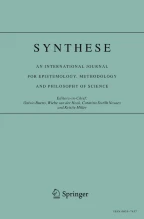Abstract
When the results of an experiment appears to disconfirm a hypothesis, how does one know whether it’s the hypothesis, or rather some auxiliary hypothesis or assumption, that is at fault? Philosophers’ answers to this question, now known as “Duhem’s problem,” have differed widely. Despite these differences, we affirm Duhem’s original position that the logical structure of this problem alone does not allow a solution. A survey of philosophical approaches to Duhem’s problem indicates that what allows any philosopher, or scientists for that matter, to solve this problem is the addition of epistemic information that guides their assignment of praise and blame after a negative test. We therefore advocate a distinction between the logical and epistemic formulations of Duhem’s problem, the latter relying upon additional relevant information about the system being tested. Recognition of the role of this additional information suggests that some proposed solutions to the epistemic form of Duhem’s problem are preferable over others.
Similar content being viewed by others
Notes
An anonymous reviewer usefully notes the possibility of "pragmatic" resolutions that are not themselves epistemic: for instance, the choice to favor a hypothesis that would lend theoretical support to more easily or cheaply conducted experiments over a rival hypothesis. We agree that such pragmatic considerations play a role in scientific decision-making and are important topics of study, but we restrict our inquiry here to the prospects of epistemically justified resolutions. Our selection and evaluation of proposed solutions in the following sections thus rests on appeals to epistemic values such as fit with the evidence, independent support for assumptions, or explanatory power, rather than pragmatic ones.
For one thing, Pr(E| ~ H) plausibly depends on how many alternative theories (e.g. H1, H2,… Hn) would predict E, and with what strength. Mayo (1997) points out that since the number of alternative theories that could predict E can plausibly be expanded or contracted at will with the help of some theoretical ingenuity and historical selectivity, the strength of Pr(E| ~ H) can likewise be varied at will.
In this quotation, we’ve substituted “Ha” and “Hb” for Dorling’s notation (“T” and “H” respectively), to maintain consistency with our notation.
Note that by treating theory and auxiliary statements differently in his model, Dorling imports another kind of asymmetry into his description of the problem. For instance, he counsels us to consider explanations by alternative theories, but doesn't describe the evaluation of auxiliaries in the same way.
References
Burnham, K., & Anderson, D. R. (2004). Multimodel inference: Understanding AIC and BIC in model selection. Sociological Methods & Research,33(2), 261–304.
Darden, L. (1990). Diagnosing and fixing faults in theories. In J. Shrager & P. Langley (Eds.), Computational models of scientific discovery and theory formation (pp. 319–346). San Mateo: Morgan Kaufmann Publishers.
Darden, L. (1991). Theory change in science: Strategies from Mendelian genetics. Oxford: Oxford University Press.
Dorling, J. (1979). Bayesian personalism, the methodology of scientific research programmes, and Duhem’s problem. Studies in History and Philosophy of Science,10(3), 177–187.
Duhem, P. (1914/1954). The aim and structure of physical Theory, 2nd (Edn.) (P. Weiner, Trans.). New York: Atheneum.
Fairweather, A. (2012). The epistemic value of good sense. Studies in History and Philosophy of Science,43, 139–146.
Fitelson, B., & Waterman, A. (2005). Bayesian confirmation and auxiliary hypotheses revisited: A reply to Strevens. British Journal for the Philosophy of Science,56(2), 293–302.
Howson, C., & Urbach, P. (1989). Scientific reasoning: The Bayesian approach. La Salle: Open Court.
Ivanona, M., & Paternotte, C. (2013). Theory choice, good sense and social consensus. Erkenntnis,78, 1109–1132.
Ivanova, M. (2010). Pierre Duhem’s good sense as a guide to theory choice. Studies in History and Philosophy of Science,41, 58–64.
Mayo, D. G. (1997). Duhem’s problem, the Bayesian way, and error statistics, or ‘What’s belief got to do with it?’. Philosophy of Science,64(2), 222–244.
Mayo, D. G. (1996). Error and the growth of experimental knowledge. Chicago: University of Chicago Press.
Sober, E. (2004). Likelihood, model selection, and the Duhem-Quine problem. The Journal of Philosophy,101(5), 221–241.
Strevens, M. (2001). The Bayesian treatment of auxiliary hypotheses. British Journal for the Philosophy of Science,52, 515–537.
Stump, D. (2007). Pierre Duhem’s virtue epistemology. Studies in History and Philosophy of Science,38, 149–159.
Weber, M. (2009). The Crux of crucial experiments: Duhem’s problems and inference to the best explanation. British Journal for the Philosophy of Science,60(2009), 19–49.
Author information
Authors and Affiliations
Corresponding author
Rights and permissions
About this article
Cite this article
Dietrich, M., Honenberger, P. Duhem’s problem revisited: logical versus epistemic formulations and solutions. Synthese 197, 337–354 (2020). https://doi.org/10.1007/s11229-018-1845-1
Received:
Accepted:
Published:
Issue Date:
DOI: https://doi.org/10.1007/s11229-018-1845-1
